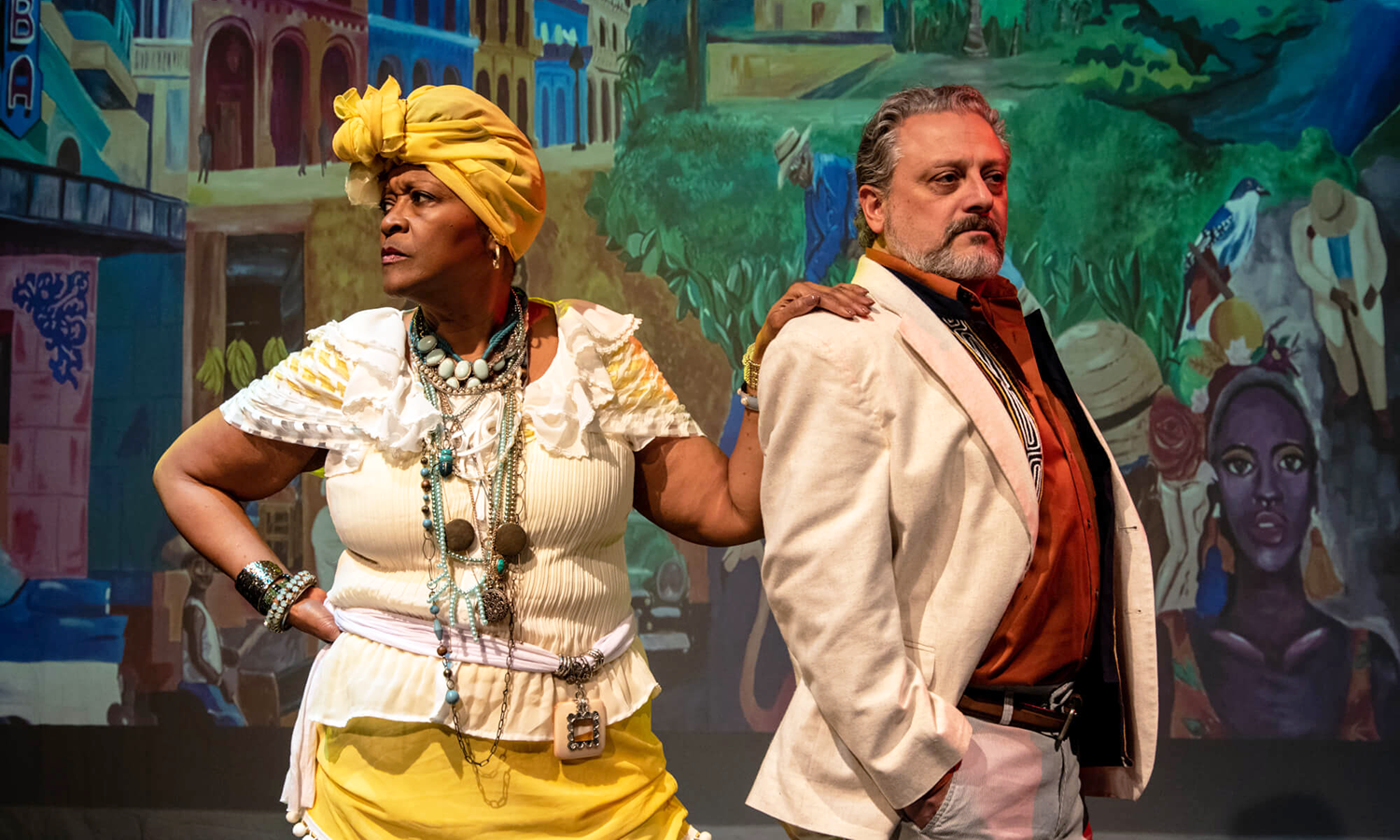It goes without saying that any conversation about language politics is code for a conversation about identity and culture. In the past on HowlRound, Arlene Martínez-Vázquez has beautifully articulated strategies for bilingual theatre, and Jose Solís has described the process and motivation for devising Shakespeare with Latinx artists. But what happens when we add another language to English-language stories performed for audiences in English-dominated countries? This differs from staging a work that is entirely in translation (the Greeks) and from translating and transposing a work to another culture (Cherríe Moraga and Luis Alfaro’s adaptations of the Greeks). When the playtext is already primarily or entirely in English, adding another language presents a dramaturgical challenge to linguistic power relationships.
I want to explore the strategies and considerations for adding a language to a production that’s not included in the original playtext. Although there is much to be said about the position of Shakespeare and other canonized authors in educational and arts institutions as well as popular culture, I want to focus on strategies for countering the linguistic racism of these English-language stories that prevail in our theatres. While the following considerations can be applied to any language added to the standard-bearers of the English-language canon, I look to the wealth and breadth of Latinx Shakespeares to draw on this long-standing theatrical tradition.
When the playtext is already primarily or entirely in English, adding another language presents a dramaturgical challenge to linguistic power relationships.
Strategies for Integrating Foreign Languages Onstage
When incorporating a second language into a classic text, theatremakers may want to do so for a variety of reasons, including:
1) For humor. Sprinkling words and phrases from another language into the text can add humor and serve as a linguistic reminder of another culture. This strategy requires a similar usage of language from characters across social strata so as not to appear superficial or to put the additional language and culture on the periphery. For example, sprinkling in a “¡Dios Mío!” here and there can generate laughs, but it can also be unintentionally essentializing and create an “othered” effect.
2) To accentuate the ostracization of a character. Giving an outcast character who speaks another language an onstage translator (or leaving them without) can further emphasize their plight.
3) For intimacy between characters. Another language can quickly establish close relationships between characters. Monolingual English-speaking audiences don’t need to understand the dialogue to pick up on intimacy; other elements beyond the spoken words can deliver the meaning.
4) For intimacy with the audience or to break the fourth wall. Bilingualism, “Spanglish,” and other kinds of language play can pull the audience in, whether or not they are primarily Latinx, Spanish-speaking, or fully bilingual. The representation of characters who live between languages can serve as an inclusive bridge to audience members who live the same way.
5) To designate physical or metaphorical spaces for one culture. One language can be used in the home, at work, for heightened emotion, or for private reflection. This can also be gendered, class-associated, and/or inflected by power relationships. Certain monologues, depending on theme or style, might be better done in the non-English language, depending on the character’s relationship to that particular language.
6) To show generational change. Oftentimes a foreign language or accent is used by older characters and not by younger ones to convey assimilation or acculturation among the younger group. Different forms of language play can also signal the different generations or families; linguists distinguish between different types of code-switching—within a sentence, outside a sentence, within a phrase, and sometimes within a word. One generation may use a different form than another.
7) To show cultural difference. This type of cultural-linguistic trope is what I have previously termed “the West Side Story Effect”: the rewriting of any type of difference in Shakespeare—including class, family, and region—as cultural-linguistic difference. Adding in another language may accentuate, change, or make more legible that distinction.
8) To clarify or modernize. Translation typically involves some degree of modernization; translations of Chekhov, Molière, and the Spanish Golden Age playwrights may retain heightened language, syntax, or style to signal antiquated or stylized verse and prose but may also make adjustments to sound more “modern” than the original. But translating antiquated English, such as Shakespeare’s use of “wherefore,” to contemporary English or any language familiar to the audience makes it easier for the audience to understand that it means “why,” not “where.”
9) To appeal to two monolingual audiences. Repetition of a word or phrase in the two languages audiences speak is also a strategy for clarification of plot points.
10) To distance the audience. Including another language in a production can be a purposeful alienation tactic when supertitles with translation are posted for the audience. This can add to the foreignness of a scene and distance the audience from the locale and/or time period.
Bilingualism, “Spanglish,” and other kinds of language play can pull the audience in, whether or not they are primarily Latinx, Spanish-speaking, or fully bilingual.
Considerations for Adding Another Language into a Performance
When theatremakers take on the task of adding a second or tertiary language to a production, there are several factors to consider when integrating them into text and performance. It is important to note that monolingual plays often contain a phrase or two in another language. For example, in Shakespeare’s Much Ado About Nothing Dogberry says, “Comparisons are odorous. Palabras, neighbour Verges,” employing a condensed version of the phrase “pocas palabras” to urge brevity. But the linguistic diversity within Shakespeare’s plays, like the above example, can be obscured when Spanish is added, like it has been in productions of Much Ado over fifteen times in the last forty years in the United States. In this English-language classic, the use of this Spanish phrase in the plot’s Italian setting gets lost when more lines are translated for performance.
The long-standing relationship of Shakespeare to the English language often downplays the linguistic diversity of his plays and audiences may assume a monolingualism in Shakespeare that complicates the considerations for including additional languages in performance. Given this knowledge, it’s important for theatremakers to strategize the implications for including a second or third language in a production and how that may alter the production’s reception. The following is a list of considerations for these artists.
1) Politics affect theatrical bilingualism. The use of Spanish, Quechua, German, Korean, and Farsi will all be interpreted differently by audiences depending on how the culture(s) associated with that language are viewed within the larger culture of the playwright, the performers, and the production location.
2) A production’s aural soundscape includes more than language. Music can be used to extend the affective quality of another language when the dialogue returns to English. Sound effects, accents, music, and language all contribute to the soundscape. Also, set design, architecture, and crowd scenes can invoke other languages and cultures.
3) Motivations for using foreign language will be evident. If sprinkling in another language is merely a tactic for engaging new audiences, it can be an access point or, conversely, feel topical. People return to familiar stories for the pleasure of hearing the words and experiencing the narrative in a different way or at a different time in our lives. Retelling a story and including a language that might engage a wider audience can be an inclusive access point and a source of comfort.
4) Characterization and pacing change in different languages. Adding another language may slow down or speed up the production. For example, Shakespeare’s metaphors may take more or fewer words to express in another language, just as counting to ten in Spanish involves nineteen syllables but only eleven in English. Actors and directors might be less likely to draw out lines that are famous in English when they are spoken in another language.
5) Translations are often in today’s language. “Code-switching” means shifting between two languages, but mixing languages from two time periods (i.e. Shakespearean English and modern-day Spanish), or what I term “cross-temporal code-switching,” is not realistic to any society and will contrast with naturalistic acting methods. This disjunction in language challenges a cohesive and linear politics of time and narrative, which can either enhance or work against the storytelling. In modern-dress productions of Shakespeare, characters might wield guns yet refer to swords and the audience adjusts to this disjunction; trust that the audience can do the same with language.
6) Bilingual actors may not be trained in bilingual vocal methods or bilingual acting methods. Even if actors are bilingual, they may not have acted in both languages. Bilingual vocal coaches and coaching are available and should be utilized.
7) The introduction of a tertiary language may “normalize” two primary languages. Including a third language in a production, especially if it’s a minority language and/or if it’s used sparingly, can function as a “foreign” aural touchpoint that normalizes the two primary languages. For example, in Latinx Shakespeares, some productions have employed Indigenous languages, ASL, and Creole for tertiary characters, thereby recalibrating the linguistic entry points for audiences and challenging the representation of Latinx peoples as only speaking Spanish and/or English.
8) Curating an artistic season or repertory of plays that includes those from specific cultural or linguistic groups can emphasize that culture or language. Programming choices can also show a theatre’s commitment to a particular ethnoracial or national group. Programming strategies, outreach programs, advertising, supertitles for some performances, and targeted mailers are examples of how companies can enhance audience expectations before the performance begins.
9) Not everyone onstage and on the production team needs to be fluent in the secondary language. But there does need to be a team of people from various backgrounds (culturally and professionally, such as a dramaturg, vocal coach, or accent coach) to ensure a culturally and linguistically aware production.
10) Accents in the secondary language should cohere as they do in the primary language. While this list addresses language, note that not all Spanish accents are the same, and in an English-dominant production, the Spanish needs to sound as regional, specific, and cohesive as the English.
Including a third language in a production, especially if it’s a minority language and/or if it’s used sparingly, can function as a “foreign” aural touchpoint that normalizes the two primary languages.
Staging Linguistic Diversity
The United States has never been monolingual, and any type of linguistic encounter inserted into the staging of canonized, English-language writers will embed into the production a challenge to the colonialist and patriarchal legacies that either overshadow or go unrecognized in the work by audiences today. What Latinx Shakespeares—and any performance of the classics with additional languages—do is challenge the faulty perception of both a monolingual United States and of a monolingual Shakespeare.
Shakespeare created and invoked words and phrases from various languages and cultures to address the multiple audiences, contexts, and linguistic and cultural exchange of his time. As his linguistic dexterity becomes elided with the antiquated English of his poetry or has been subsumed into the English language, one possibility for challenging the linguistic racism of English-dominant stories in English-dominant societies is to add Spanish or any other language into performance today. Shakespeare’s language has become so engrained in theatre, popular culture, and media that the next new—or, rather, old—dramaturgy is a linguistic one.



Comments
The article is just the start of the conversation—we want to know what you think about this subject, too! HowlRound is a space for knowledge-sharing, and we welcome spirited, thoughtful, and on-topic dialogue. Find our full comments policy here